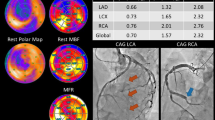Summary
Tracer techniques have provided new insight in cardiology by allowing noninvasive studies of myocardial perfusion, function, metabolism, and, more recently, ligandreceptor interaction. Positron emission tomography allows accurate quantification and the use of natural substrates labelled with 11C, 13N, or 15O.
Myocardial metabolism is complex and utilizes a number of substrates, primarily fatty acids. Fatty acids utilization can be studied with 11C palmitate, while 14C acetate more selectively traces TCA cycle activity and reflects myocardial oxygen utilization. Glucose uptake can be traced using 18F deoxyglucose, a glucose analog that is a substrate for hexokinase but is not further metabolized. Flow and oxidative glucose metabolism are usually coupled, and thereby the uptake of FDG and perfusion tracers are usually similar. In myocardial ischemia, however, glucose utilization can persist due to anaerobic glycolysis, and its uptake is frequently enhanced. Clinical applications of the use of metabolic studies in patients with ischemic heart disease are presented.
Similar content being viewed by others
References
Bergmann SR, Fox KAA, Geltmann EM, et al. Positron emission tomography of the heart. Prog Cardiovasc Dis 1985;28:165–194.
Syrota A. Approche atraumatique de la perfusion, du métabolisme et des récepteurs myocardiques par la tomographie par émission de positrons. Arch Mal Coeur 1988; 81:53–59.
Lerch RA, Ambos HD, Bergmann SR, et al. Localization of viable ischemic myocardium by positron emission tomography with 11C-palmitate. Circulation 1981;64:689–699.
Schon HR, Schelbert HR, Robinson G, et al. C-11 palmitic acid for the noninvasive evaluation of regional myocardial fatty acid metabolism with positron-computed tomography. I. Kinetics of C-11 palmitic acid in normal myocardium. Am Heart J 1982;103:532–547.
Scheuer J, Brachfeld N. Myocardial uptake and fractional distribution of palmitate-1-C14 by the ischemic dog heart. Metabolism 1966;15:945–950.
Rothlin ME, Bing RJ. Extraction and release of individual free fatty acids by the heart and fat depots. J Clin Invest 1961;40:1880–1886.
Fox KAA, Abendschein DR, Ambos HD, et al. Efflux of metabolized and nonmetabolized fatty acid from canine myocardium. Implications for quantifying myocardial metabolism tomographically. Circ Res 1985;57:232–243.
Lindeneg O, Mellemgaard K, Fabricius J, et al. Myocardial utilization of acetate, lactate and free fatty acids after ingestion of ethanol. Clin Sci 1964;27:427–435.
Buxton DB, Nienaber CA, Luxen A, et al. Noninvasive quantitation of regional myocardial oxygen consumption in vivo with (1–11C) acetate and dynamic positron emission tomography. Circulation 1989;79:134–142.
Brown MA, Myears DW, Bergmann SR. Validity of estimates of myocardial oxidative metabolism with carbon-11 acetate and positron emission tomography despite altered patterns of substrate utilization. J Nucl Med 1989;30:197–198.
Brunken R, Schwaiger M, Grover McKay, et al. Positron emission tomography detects tissue metabolic activity in myocardial segments with persistent thallium perfusion defects. J Am Coll Cardiol 1987;10:557–567.
Brunken R, Tillisch J, Schwaiger M, et al. Regional perfusion, glucose metabolism and wall motion in chronic electrocardiographic Q-wave infarctions: Evidence for persistence of viable tissue in some infarct regions by positron emission tomography. Circulation 1986;73:951–963.
DeLandsheere D, Raets D, Pierard L, et al. Regional myocardial perfusion and glucose uptake: Clinical experience in 92 cases studied with positron emission tomography. Eur J Nucl Med 1989;15:446.
Tillisch J, Brunken R, Marshall RC, et al. Reversibility of cardiac wall motion abnormalities predicted by positron tomography. N Engl J Med 1986;314:884–888.
Camici P, Ferrannini E, Opie LH. Myocardial metabolism in ischemic heart disease: Basic principles and application to imaging by positron emission tomography. Prog Cardiovasc Dis 1989;32:217–238.
Fragasso G, Chierchia SL, Conversano A, et al. Temporal dependence of residual tissue viability after myocardial infarction. A study based on positron emission tomography. Eur Heart J 1989;10:52.
Knapp WH, Helus F, Ostertag H, et al. Uptake and turnover of L-(13N)-glutamate in the normal human heart and in patients with coronary artery disease. Eur J Nucl Med 1982;7:211–215.
Mahaux V, Rigo P, Delfiore G, et al. 13N-glutamate: Myocardial blood flow marker in positron emission tomography. Eur Heart J 1988;9(Suppl 1):364.
Martin GV, Caldwell JH, Rasey JS, et al. Enhanced binding of the hypoxic cell marker (3H)fluoromisonidazole in ischemic myocardium. J Nucl Med 1989;30:194–201.
Shelton ME, Dence CS, Hwang DR, et al. Myocardial kinetics of fluorine-18 misonidazole: A marker of hypoxic myocardium. J Nucl Med 1989;30:351–358.
Schelbert HR, Schwaiger M. PET studies of the heart. In: Phelps M, Mazziotta J, Schelbert HR, eds. Positron emission tomography and autoradiography: Principles and applications for the brain and heart. New York: Raven Press, 1986;599–615.
Weiss ES, Hoffman EJ, Phelps ME, et al. External detection and visualization of myocardial ischemia with 11C substrates in vitro and in vivo. Circ Res 1976;39:24–32.
Geltman EM, Biello D, Welch MJ, et al. Characterization of transmural myocardial infarction by positron emission tomography. Circulation 1982;65:747–755.
Selwyn AP, Allan RM, Pike V, et al. Positive labeling of ischemic myocardium: A new approach to patients with coronary disease. Am J Cardiol 1981;47:81.
Marshall RC, Tillisch JH, Phelps ME, et al. Identification and differentiation of resting myocardial ischemia and infarctions in man with positron computed tomography, F-18 labelled fluorodeoxyglucose and N-13 ammonia. Circulation 1983;67:766–778.
Rigo P, DeLandsheere C, Raets D, et al. Myocardial blood flow and glucose uptake after myocardial infarction. Eur J Nucl Med 1986;12:S59-S61.
DeLandscheere C, Raets D, Pierard L, et al. Investigation of myocardial viability after an acute myocardial infarction using positron emission tomography. In: Heiss W, Pawlik G, Herholz K, Wienard, eds. Clinical efficacy of positron emission tomography. Dordrecht: Martinus Nijhoff, 1987:279–296.
DeLandsheere C, Raets D, Pierard L, et al. Fibrinolysis and viable myocardium after an acute infarction: A study of regional perfusion and glucose utilization with positron emission tomography. Circulation 1985;72:111–393.
Author information
Authors and Affiliations
Rights and permissions
About this article
Cite this article
Rigo, P., De Landsheere, C., Melon, P. et al. Imaging of myocardial metabolism by positron emission tomography. Cardiovasc Drug Ther 4 (Suppl 4), 847–851 (1990). https://doi.org/10.1007/BF00051291
Issue Date:
DOI: https://doi.org/10.1007/BF00051291




